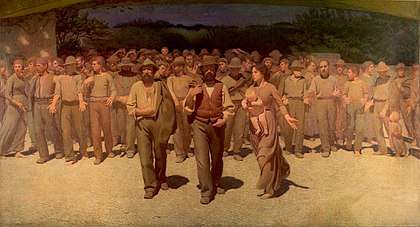The Fourth Estate (painting)
The Fourth Estate is a famous picture painted by Giuseppe Pellizza da Volpedo between 1899 and 1901, originally entitled The Path of Workers.[1]
| The Fourth Estate | |
|---|---|
| Italian: Il quarto stato, Spanish: El Cuarto Estado | |
 | |
| Artist | Giuseppe Pellizza da Volpedo |
| Year | c. 1901 |
| Type | Oil on poplar |
| Dimensions | 293 cm × 545 cm (115 in × 215 in) |
| Location | Museo del Novecento, Milan |
Name
The term Fourth Estate refers here to the exploited working class. Before the revolution, French society was divided into three estates or orders: the First Estate (clergy), Second Estate (nobility) and Third Estate (commoners). Although the Third Estate was by far the largest, it was very heterogeneous comprising everything from urban professionals and businessmen, to farmers and labourers. The French Revolution marks the ascent of the bourgeoisie as the ruling class from within the Third Estate. Social and industrial transformations accelerate the perception of the working class as a distinct social class - a "Fourth Estate" producing all the welfare of modern economy, but deprived of any political representation. The "Fourth Estate" is depicted here as marching peacefully, and yet determined, towards a more equitable society and a brighter future where they will no longer be exploited.
Description
The painting is in the "chromoluminarist" or divisionist style, which was very popular in early 20th century Italy. The style, similar to the earlier pointillism, uses the juxtaposition of individual points of colour to create new chromatic experiences, rather than mixing paints before they reach the canvas.[2] One of the reasons why this method was popular was the idea that it leads to the most natural depiction of lights that was possible.[3]
Considered a symbol of the 20th Century from both an artistic and a social point of view, the painting depicts a workers' strike.[4] The divisionist style is used to great effect to depict the strikers casually walking towards the light, their shadows firmly behind them.
The painting represents the full development of this theme, which the artist already dealt with in paintings such as The Ambassadors of Hunger (1892),[5] Stream of People (1896)[6] and a preparatory sketch of 1898, The Path of Workers. The composition of the painting is balanced in its shapes and vibrant in its light, giving the perfect idea of a mass movement.
Characters
Many of characters depicted in the painting are based on friends of the artist, on socialist activists and on natives of Volpedo, while the woman holding a baby that appears in the forefront is based on Teresa Bidone, the artist's wife.[7]
Display
The Fourth Estate was first unveiled to the public at the Prima Esposizione Internazionale d'Arte Decorativa Moderna, held in Turin in 1902. After failing to garner initial public or critical acclaim, the painting started becoming more and more well known through its reproduction in various socialist newspapers of the 1910s. Because of the subject matter, exhibitions routinely refused to exhibit the painting during those early years. Pellizza would only see it exhibited once, in 1907, before his death by suicide that same year.[8]
The painting lingered in obscurity in the propriety of the artists heirs until 1920, when after it was exhibited as part of a retrospective, it impressed a socialist councilor of Milan, who managed to purchase it through public subscription and have it displayed in the Sforza Castle. It was not to be on display long, as during the reign of the fascist regime, the painting was rolled up and held in storage. After the war, the painting was reinstated for public view and was displayed initially in the Palazzo Marino.[9] It was during this time that its fame increased and it became one of the most famous Italian paintings of the 20th century.
After going through a restoration in 1976, The Fourth Estate found a new home in the Galleria d'Arte Moderna in Milan, where it remained until 2010, when it was moved to its current location, Milan's Museo del Novecento.
An earlier version is held in the Pinacoteca di Brera, also in Milan. Museo del Novecento considers it as one of its most valuable masterpieces and has dedicated an entire room to its viewing.[1]
In film
The opening credits of Bernardo Bertolucci's epic historical film 1900 are displayed over a slow zoom out of this painting.[10]
References
- Novecento, Museo del. "Giuseppe Pellizza da Volpedo and The Fourth Estate". www.museodelnovecento.org. Retrieved 2019-01-25.
- "DIVISIONISM. The origin of modern painting in Italy". The Art Post Blog | Art and Artists Italian Blog. 2016-06-23. Retrieved 2019-01-25.
- "Italian Divisionism, Neo-Impressionism in Italy". www.visual-arts-cork.com. Retrieved 2019-01-25.
- Stone, Eric Golo (21 October 2015). "Giuseppe Pellizza da Volpedo - The Fourth Estate (1901)". Flash Art. Retrieved 2019-01-25.
- "The Ambassadors of Hunger by Giuseppe Pelizza da Volpedo , oil on canvas". Getty Images. Retrieved 2019-01-25.
- "Stream of people , 1896 by Giuseppe Pellizza da Volpedo . Study for The Fourth Estate". Getty Images. Retrieved 2019-01-25.
- Crosetti, Maurizio (25 May 2001). "I nipotini del Quarto Stato". la Repubblica. Retrieved 25 January 2019.
- "PELLIZZA DA VOLPEDO, Giuseppe in "Dizionario Biografico"". www.treccani.it (in Italian). Retrieved 2019-01-25.
- Zuffi, Stefano (11 February 2016). "Il Quarto Stato di Giuseppe Pellizza da Volpedo". Palazzo Ducale Fondazione per la Cultura (in Italian). Retrieved 2019-01-25.
- Bosworth, R. J. B.; Dogliani, Patrizia (1999). Italian Fascism: History, Memory and Representation. London & New York: Springer. p. 122. ISBN 9781349272457.